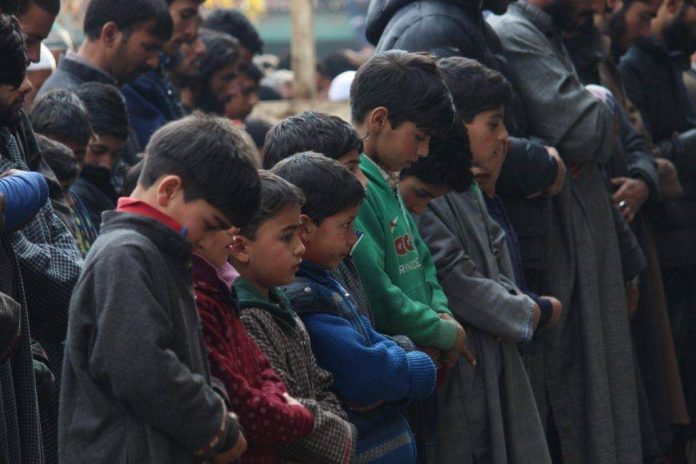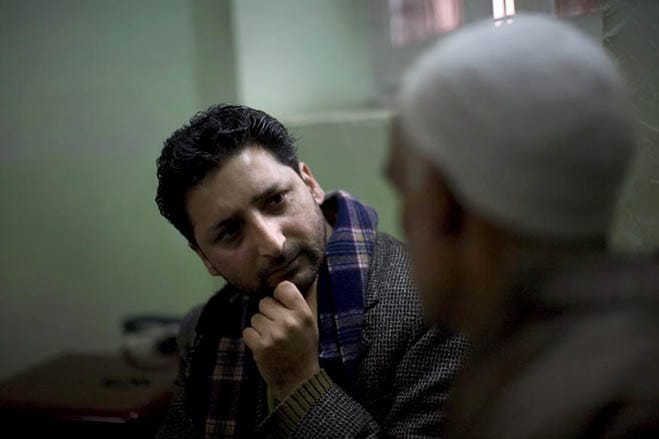What are many Indian teengaer’s biggest concerns when they are 15 years old? Homework? Upcoming exams? Family pressures? No We do not need an expert to tell us that teenagers are subject to extreme social pressures. Now, imagine all these issues and place it in the context of a conflict that has been raging in your region for as long as you can remember; for as long as your parents can remember.

A group of childrens offering funeral prayers of a militant in Kashmir. PIC Kamran Yousf
No one has an easy life in Kashmir, but can we even begin to imagine the kind of pressure, anger, disbelief, frustration and general helplessness that a school student in Kashmir undergoes? A student in a town like Shopian, for example, might consider himself lucky just to be alive: they have seen their friends being shot, injured, and arrested. As a Kashmiri teenager, what do you do? Not protest against the occupation? That might still get you caught in a crossfire. Keep quiet and focus on your studies? How do you do that when there is an encounter happening right next to your house? Or when tear gas shells land inside your house?
In December, two teenagers–Saqib Majeed and Mudassir Paray–became another statistic in Kashmir. They were killed in an encounter with security forces and Indian media barely noticed the fact that the two ‘militants’ were 17 and 14 years old It made no difference. What forces a 15-year-old to pick up a gun? What forces a 12-year-old to pick a stone to hurl at security forces? What makes a 17-year-old believe that death at the hands of Indian forces is a better option that living a ‘normal’ life?
In this 6-part series, TwoCircles.net’s Kashmir correspondent Auqib Javeed looks at all the aspects of being a teenager in Kashmir: a militant, a protester, a mere bystander and a victim. If you pick a gun, you will be labelled a militant and shot; if you pick a stone, you will be labelled ‘anti-India’ and arrested and put in juvenile homes. If you are lucky, you will only be beaten up a little; if you are not, you will end up with bruises that will never leave you. And if you do neither, you still stand a very high chance of ending up being arrested or killed.
In the last of the six-part series, Javeed speaks with Dr Arshad Hussain, one of the leading psychiatrist of the Kashmir. Dr Hussain, who has been practising for over two decades, warns that the ongoing conflict is having a severe and irreparable damage of the minds of the teenagers. The following are the excerpts:

Dr. Arshad Hussain
Just as we provide good nutrition to our children for their physical development, we also need to provide an environment of love and carefree of abuse and violence for their normal mental development. The environment free of violence will lead to the making of good humans. Any kind of abuse to children, be it physical, sexual or verbal has the worst impact one can imagine on their mental health. It traumatises them, and many times to an extent that they are not able to live beyond this trauma. It leaves them with a permanent scar on their lives. If adults get traumatised they usually manifest: either they will cope (carry on) or they might succumb (post-traumatic stress) but in case of children, it damages their development, which actually means what kind of person they become later on depends upon how they processed their traumas.
What is the outcome of these traumas on the children?
When humans face trauma generally there could be three kinds of outcomes, a positive outcome, a negative outcome and a neutral outcome. In most cases, we find a neutral outcome- which means kids are traumatised but they try to move on with family support, peer support, social networking and bonding. Culture provides an important buffer from helping them not to slide into the black hole of trauma. It remains a scar they don’t forget it but they modulate it in a way that they still live a normal life.
However, in many cases, trauma leads to mental health problems. Some of them become complex in nature; where they re-enact their own traumas by traumatising others, hence having serious consequences for societies putting them into a vicious cycle of trauma the whirlpool from which they are not able to emerge unscathed.
What has been your experience in dealing with the children in Kashmir?
The current environment in Kashmir is unfortunately filled with traumatising events which are not good for the development of a child. This is an atmosphere of fear and for children, there is trauma and violence being played over and over again. I hope and pray that our kids imbibe this fear and trauma and modulate and process it in a way that they fight for justice without the need for vengeance and don’t fall into the dark hole of trauma. But if my optimism doesn’t come true, we are looking at serious mental health morbidity.
What needs to be done according to you?
As a mental health professional, I hate violence. If we want a non-violent society we have to work towards the same. You have to create that kind of atmosphere. You can’t dream of a peaceful society when you use non-violent methods. We can discuss, debate, agree to disagree and incentivise peaceful modes of protest. History has taught us that trauma begets trauma. If you traumatise now you are investing in a violent future. You can disagree with others, but what is wrong with listening? You use violent methods you will get it back. If we want a peaceful atmosphere we have to incentivise peaceful methods of dissent.
Courtesy: Two Circle
